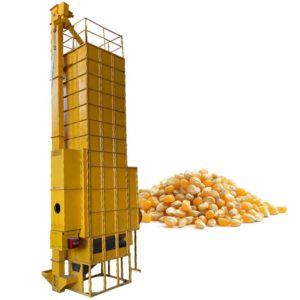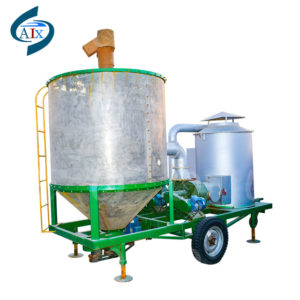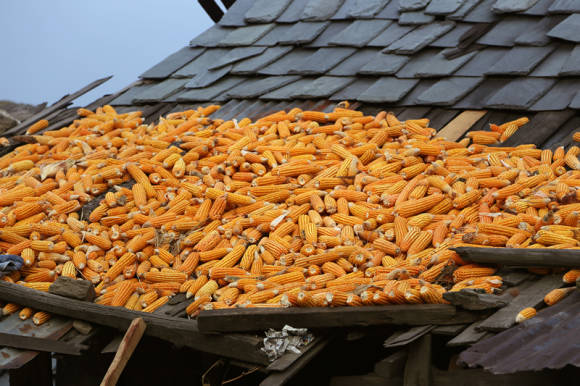What is a corn dryer, how it works and how to make it yourself
Corn continues to be in demand on the world market, despite the drop in purchase prices. But there is one important nuance - the moisture content of the harvested grain is 35-40%. Long-term storage requires 15% or less. Therefore, special dryers are used to reduce the moisture content of raw materials.
The content of the article
What is a corn dryer

Grain dryers appeared thanks to the emergence of high-performance combines. Harvesting crops in large volumes made us think about an accelerated way of carrying out preparatory work before storage.
In the past, cereals were dried in the open air in the sun. This is a long-term method and does not guarantee high-quality drying. Besides for industrial volumes large areas were required. Therefore, grain dryers were created.
These units are divided into mobile and stationary. The differences lie in their design features.
Corn dryers are of the following types:
- Mine. It is a stationary unit mounted on a solid foundation. It has 2 vertical shafts with the same volume. Drying of corn is carried out by means of hot air. In one pass, grain loses no more than 6% moisture, therefore, several passes are required for high-quality drying. Depending on the dimensions, they dry from 8 to 16 tons in one cycle.
- Drum. They are considered mobile units, since they are compact in size. The design has 3 main elements: drum, heating zone, cooling chamber. Although small, drum dryers are quite efficient. For a shift, such devices are capable of processing 10-600 tons of corn, depending on the model.

- Chamber. These are large structures that are used on an industrial scale. They have 2 chambers with a perforated bottom. Grain is covered with layers: each next after drying the previous one. The design has special screws that are designed for mixing layers. Chamber dryers provide the required corn moisture percentage in one pass.
- Recirculating. These dryers operate on a principle similar to mine dryers. The grain is split into 2 streams. After drying in the first shaft, a small amount of corn is redirected to the second. There it is mixed with wet raw materials. Thanks to this scheme, partially dried grain is obtained. After that, it goes back to the first shaft. The cycle is repeated until completely dry.
Operating principle
Drying of grain takes place thanks to hot air. The essence of the work is to reduce the moisture content of corn to 15%. Without this, grain cannot be stored for a long time.
Balance is important. An increase in temperature increases the productivity of the installation, but if it is too hot, the grain will burn. Therefore, a temperature control system is always included in the design of the dryer.
How corn is dried on an industrial scale
Most often on an industrial scale, corn is dried on the cob. For this, a chamber grain dryer is used. The process takes place at temperatures from +35 to + 50 ° C.
Removal of 1 kg of moisture requires about 8.5 MJ of thermal energy. The efficiency of chamber dryers is approximately 35%, and of mine dryers - 60%.
At the first stage, they start with preliminary heating of the raw material. To do this, use elevated temperatures, since the embryo heats up more slowly.Based on scientific experience, heating at a temperature of + 50 ° C reduces the drying time of raw materials by 7 hours and increases moisture yield by almost 11%. As a result, the productivity of the plant increases by 22% when compared to conventional drying.
The corn is first dried on the cob, since wet kernels are difficult to separate without damage. The ears are dried to 18-20% moisture content, after which the grain is threshed. Then it is sent for final drying.
There is a differentiated treatment. It allows you to increase the productivity of the units by 20-30%. The principle is to gradually increase the temperature.
It is interesting:
What is a corn plow and how to make it yourself
How to clean corn from grains at home: the best life hacks for quick processing of a vegetable
How to distinguish feed corn from food corn and the uses of both types
Dryer specifications and dimensions
In recent years, mine grain dryers are most often used. The technical characteristics of the units are presented in the table.
| Characteristic | Minimum rate | Maximum rate |
| Removal of moisture from corn from 25% to 15%, t / h | 2,5 | 22 |
| Capacity, m³ | 16 | 78 |
| power, kWt | 12 | 60 |
| Natural gas consumption per ton, m³ | 1,1 | 1,1 |
| Height, m | 10,5 | 24,9 |
| Length, m | 5,35 | 6,5 |
| Width, m | 5 | 5,7 |
How to make a do-it-yourself corn dryer
It is easy to make a corn dryer with your own hands. Its performance cannot be compared with factory counterparts, but the cost will be minimal.
What materials can be made
To make a dryer, you will need the following materials and tools:
- metal barrel;
- metal pipe with a diameter of 200 mm;
- turbofan;
- a heat-resistant pipe for a turbofan (it is usually rubber, but there are also metal ones);
- gas-burner;
- welding machine;
- drill;
- Bulgarian.
Step-by-step instruction
After preparing all the materials, they start assembling:
- In a pipe with a section of 200 mm, holes are made with a drill over the entire surface at a distance of 20 mm from each other. Hole diameter - 2-3 mm. The upper part is brewed.
- In the same pipe and in the barrel, one hole is cut each with a diameter that coincides with the pipe for the turbofan.
- On the opposite side, a door is cut into the barrel at the bottom. It will be needed to extract the grain.
- The large pipe is inserted into the barrel so that the holes align. After that, they are welded.
- Connect the turbofan. To do this, they put a pipe on it and put it into the pipe in the barrel.
This completes the production. Corn is poured into the barrel for use. After that, the burner is ignited and its flame is directed to the operating turbofan. Hot air will enter the inner pipe, and from there through the holes to the dried raw materials.
How to dry grain without a dryer
Small volumes of grain are most often air dried. To do this, take some kind of sheet material and put it at a distance of several centimeters from the ground. After that, corn is spread on it. The sun will cause the ears to dry out.
After a week, the grains are removed from the cobs and sent for final drying. The raw materials are transferred under the canopy and poured onto the fabric. The place should be well ventilated. So that the raw material does not start to rot, it is stirred daily.
Many also use electric heaters. Grain is poured into low containers with a layer of up to 2 cm and placed near the heater. To ensure air circulation, a fan is additionally used.
Corn is also dried over the stove. To do this, it is poured into nets. The warm air will gradually remove moisture from the beans as you cook.
Modern fruit dryers do the job well, too. For this, the grains separated from the cobs are placed on the grates in one layer. Dried at + 40 ° C. Every 1.5 hours, the grains are mixed, and the trays are changed.

It is interesting:
What is a corn seeder: principle of operation, review of the best models
What is a corn conditioner, how does it work and how to make such a unit with your own hands
Conclusion
Corn is dried both at home and at work. It's a simple process. Factory equipment is more balanced and efficient, but expensive. Therefore, many farmers prefer to make their own dryer. This will require a little material, half of which can be found in any household.